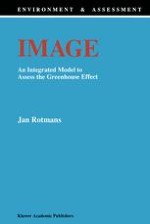
1990 | OriginalPaper | Chapter
The Carbon Cycle Model
Author : Jan Rotmans
Published in: Image: An Integrated Model to Assess the Greenhouse Effect
Publisher: Springer Netherlands
Activate our intelligent search to find suitable subject content or patents.
Select sections of text to find matching patents with Artificial Intelligence. powered by
Select sections of text to find additional relevant content using AI-assisted search. powered by
Carbon dioxide (CO2) occurs naturally in the atmosphere, and plays an important role in almost all living mechanisms. The natural carbon cycle encompasses exchange of CO2 between the atmosphere, oceans and the terrestrial biosphere of hundreds of billions tons of carbon a year. Compared with these tremendous quantities the extra man-made addition through the burning of fossil fuels and changing land use is only a small contribution to the carbon cycle. Nevertheless this minor anthropogenic injection is supposed to account for the imbalance of the carbon cycle and thus for the increase in the CO2 concentration. However, only about 40% of the man-made CO2 emissions remains in the atmosphere. The remainder is taken up by the oceans and terrestrial ecosystems. The atmospheric CO2 level has increased approximately 25% from 1900 to 1989; additionally, since 1958, the starting year of systematic accurate measurements of atmospheric CO2 at Mauna Loa, the CO2 level has increased by more than 11%. The total anthropogenic CO2 flux to the atmosphere is surrounded by uncertainties (USDOE, 1985a). In fact only the resulting flux from the combustion of fossil fuels is well known, in contrast to the flux from the terrestrial biota to the atmosphere or vice versa, which is still debated. Some argue that the terrestrial biosphere is a net sink of atmospheric CO2 (Lugo and Brown, 1980, Goudriaan and Ketner, 1984, Esser, 1987, Harvey, 1989b), while others argue that it is a net source (Houghton et al., 1983).